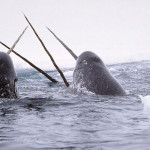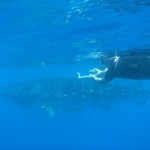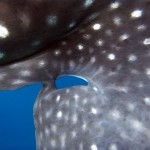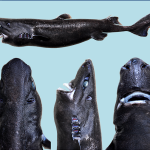Last week 70-odd of the world’s whale shark researchers converged on Atlanta for the 3rd International Whale Shark Conference. It was an unusual meeting in having so many exotic tropical countries represented in such a small group of delegates. Overall I’m happy to say it was a great success (Sorry AJC, would have linked the original and not this syndicated version, but y’know, pay walls…). One of the more interesting themes explored at the meeting was the lack of a robust global population estimate for this species. It’s the biggest fish in the world, how hard can it be to count it? Well, pretty sharking hard, as it happens. And yet, some tantalizing bits of evidence were echoed in talks from several locations and these hint to a much larger global population of this species than we are aware of. Maybe.

1st bit of evidence. Whale sharks spend a lot of time below the surface. Derrr, I might hear you say, it’s a fish… Except, it is a fish that spends (or so we thought) a disproportionate amount of time at the surface. This was based on observation (obviously) and some tagging data, but as the tagging has continued we have learned that in fact they spend much more time out of sight than we thought. We used to think they were at the surface except for occasional dives, some of which could be very deep, but now we are learning that they may stay deep for significant chunks of their lives, which puts them effectively out of detection range. And even when they are at the surface, they make such frequent short range dives that subsurface behaviour becomes a big part of their daily pie chart of time use. This means we need to up the estimates of population by a correction factor that accounts for the portion of time they spend out of sight. What should that factor be? Dunno yet, I’ll get back to you after the next conference.
2nd bit of evidence. Tags and photo ID disagree on connectivity. How groups of whale sharks in different parts of the ocean are connected (or not) is an important question both biologically and for effective conservation measures. On this matter, two different research techniques disagree somewhat, but they do it in a way that hints at a bigger population. Satellite tags have shown plenty of evidence of connectivity between different sites in the ocean, sometimes on scales of thousands of miles. For example, animals tagged in Mexico often show up in Belize, Honduras and the Gulf of Mexico, even Brazil. And yet, photographic identification databases (the most important is Wildbook for Whale Sharks, formerly ECOCEAN), show surprisingly little connectivity. Despite over a thousand individual sharks identified in Yucatan Mexico, for example, only a handful have been re-sighted in the other places I just mentioned. How is this possible if satellite tags show frequent proof positive of connectivity between these locations? Well, it’s probably because tagging is a “population independent” method, but photo ID is not. That is, the results of satellite tagging depend only on the movements of the tagged animal and not on the size of the population in either place, whereas the chances of re-sighting a whale shark photographed in one place at another place depends to a large degree on how many sharks there are at the new site. The lack of photo ID re-sightings suggests that these populations are in fact pretty big, so big that finding that familiar “face in the crowd” actually becomes statistically pretty unlikely.
3rd bit of evidence. Where are all the ladies at? The veritable explosion of whale shark science in recent years has been due in large part to the recognition of the phenomenon of whale shark aggregations, or constellations as I now like to call them (you chose it, dear reader). I’ve written a ton at DSN about the one that occurs in Yucatan Mexico but there are actually at least 12 locations in the world where whale sharks gather in large numbers – always to feed – relatively close to shore. And those are just the ones we know about. There are constellations taking place in the Red Sea, the Persian Gulf, the Philippines, Indonesia, Australia, the Seychelles, the Maldives, Mozambique and Tanzania, to name a few, but they all have one thing in common: they are dominated by immature males. Very consistently so, in fact; nearly all of these selachian sausage-fests show the same 3:1 male:female sex ratio, and the overwhelming majority of animals are immature. It’s basically an elasmobranch frat party, sans the beer pong. We know that whale sharks give birth to the genders in a 1:1 split, so you have to ask: where are all the other immature females? For that matter, where are all the mature animals, both male and female, and where are all the little ones too, under, say, 4 meters? When you really break it down, we are basing a sizable chunk of whale shark research on one small demographic slice of the whale shark pizza: immature males. That’s no way to study a species, and it certainly makes it hard to get a good handle on he global population, when the numbers you are extrapolating from represent such a small segment of the overall population.
Taken together, these bits of evidence suggest that there might be a lot more whale sharks out there than we know of. Some genetic studies have estimated populations (in the genetic sense this means the number of mature females) between 100,000 and 250,000, which is a LOT more than what we see, especially when you add in the males and immatures of both genders. But genetic techniques are no substitute for observational data and there we are still sadly lacking. One one level, this actually gives me a warm inner glow. I find it both tantalizing and fascinating to think that we are unable to account for perhaps 3/4 of the population of the world’s largest fish. It’s like the dark matter of the marine megafauna world. It gives me a strange sense of encouragement that they are out there somewhere, evading our best efforts and proving daily that the ocean still has her fair share of secrets.
“There are things known and there are things unknown, and in between are the doors of perception.” – Aldous Huxley






It was so wonderful to see and hear so many people from so many places coming together to share their knowledge and passion for these animals. The level of dedication was outstanding. I feel like the whale sharks have got a great team on their side!
I was lucky to dive Darwin Island in the Galapagos this year. Whale sharks gather there in July-September I believe but only females and all pregnant. I’m not qualified in biology at all but they were very obviously pregnant. We saw three or four every dive we did at Darwin (I think six dives in all)… although it’s hard to judge whehter we saw the same individual sometimes. I don’t know how many whale sharks it takes to make a constellation but as the vis wasn’t that great we likely missed many more than we saw. (Because of the high current our dive technique was to stay by the rocks only swimming into the blue when we saw whale sharks.. and often they were very hard to pick out.)
The females were pregnant but not feeding. The naturalist on our boat told us that they actually give birth 100s of km to the west of Galapagos so I have no idea why they gathered there. They were quite obviously not feeding (mouths firmly closed the whole time) and didn’t appear to be using it as a cleaning station (they were in the blue — in contrast to the shoals of hammerheads using it as a cleaning station who were closer in to the rocks).
Richard you’re absolutely right. Darwin’s Arch is one of 3 oceanic islands where big presumptively-pregnant females turn up with some regularity, and your experience of them was typical. We wouldn’t consider that a constellation because it seems like the ladies are using it as some sort of oceanic way-point; as you noted they aren’t feeding and seem to pass through in a sort of single file. Sounds like your guide knows something the scientific community does not, because whale shark pupping has never been observed; if you’re willing to share contact details for the operator, I would love to follow up. you can reach me here: http://alistairdove.com/contact/. Thanks for your comment!
Ah… I should be clear. Our naturalist told us that the whale sharks had been radio tracked and that they over all headed west after the Galapagos. He gave us a excellent hour long presentation which included graphs from radio tracking. The conclusion was that the birth place was to the west but he also emphasised that no birth had ever been seen exactly as you say. The radio tracks he showed were (I think) from the Galapagos Whale Shark project:
http://www.galapagoswhaleshark.com/index.php?option=com_content&view=article&id=2:track-of-all-tagged-animals&catid=1:lastest&Itemid=22
I guess it’s fairly well known? I can’t be 100% certain those were the graphs shown but he showed graphs from tagged animals tagged in the Galapagos and heading west. (Rather sadly some of the tracks he showed us went on a straight line to asian ports indicating an animal hunted.) Our trip was in July this year.
I’ll email you the name of the naturalist separately. I’m unsure of his qualifications as a naturalist but we were told all the dive guides on Galapagos liveaboards were trained as naturalists (it wasn’t made clear if this was a few day long course or much longer Masters level or further study).
Thanks for the clarification about the difference between a constellation and what we saw. The idea that they’re passing in single file on their way through fits exactly what we observed… though it does make me wonder how many individuals there must be. Large numbers I guess if we’re just hopping in and seeing at least three new individuals every time (in not-so-great visibility). They were present at Wolf too but fewer seen. However, I’m a statistician by training so I know I shouldn’t try to extrapolate much from a small sample.